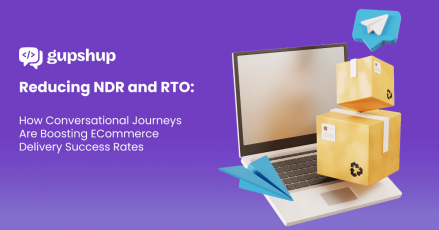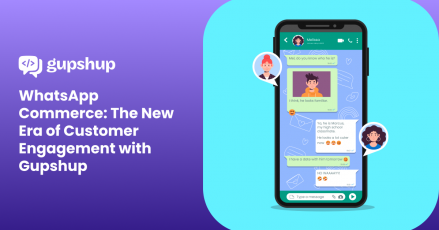Marketers’ Festive Guide: Boost Conversions and Growth with Conversational Marketing

Around the world, a noticeable excitement fills the air as September approaches. Brands are ecstatic, for the second half of the year usually brings in a surge in sales; Customers are excited because this time of the year means celebrations, family time, shopping and great deals. And ensuring both these sides are happy, while maximizing sales and customer satisfaction is the marketer, delicately balancing needs of the two groups. In these make-or-break months for annual targets, marketers are the busiest species
And as this individual sips their third cup of chai, pondering over analytics and conversion rates, they can’t help but wonder if there’s a more efficient way to connect with their audience during this crucial period. What if they could engage with potential customers instantly, personally, and at scale?

Enter Conversational Marketing – a powerful approach that could be the game-changer for marketers this festive season. Imagine being able to guide a customer from interest to purchase in real-time, even as they’re caught up in the festive rush. Picture having meaningful conversations with your audience, addressing their concerns, and offering personalized recommendations, all while they’re in the festive shopping mindset. If you’re a marketer looking to skyrocket your conversions, enhance customer experience, or simply stay ahead in the festive marketing race, this blog is for you. But before delving deeper, let’s understand:
What is Conversational Marketing and why is it the best tool for marketers
As the name suggests, Conversational Marketing is all about engaging customers in real-time through personalized conversations on messaging channels. It’s a shift from traditional one-way communication to interactive, two-way conversations. In fact, marketers can build a full stack CX and the complete marketing funnel on messaging channels by deploying various features of Conversational Marketing.
Today, most of the customer communication via email marketing or digital marketing happens either after the customer has already browsed and left the page or before they are contemplating a purchase. With Conversational Marketing, brands have the opportunity to engage with customers in real-time, right when they are expressing interest and intent. Moreover, low CTRs in email marketing and high cost of digital marketing have made conversational marketing a more cost-effective and efficient channel for reaching and engaging customers.
Imagine a scenario where a potential customer is browsing the festive collection on your website. Instead of hoping they’ll eventually convert after receiving a generic email or seeing a retargeting ad, Conversational Marketing allows you to instantly initiate a personalized dialogue on channels such as WhatsApp. A WhatsApp message informing them about cashback on their purchase, or serving precise recommendations can guide them towards the perfect shopping experience – all while they are actively engaged and in the festive shopping mindset.

What also needs to be understood is that Conversational Marketing is a generic term- it could refer to marketing on WhatsApp, RCS, Telegram, Facebook Messenger or any other messaging channels. Among messaging channels though, WhatsApp clearly stands out, thanks to its large 2 billion global user base. In emerging markets such as India, Brazil, Mexico, Indonesia, Malaysia and even the GCC region, WhatsApp sees high daily usage rates and is in fact among the most used apps in these countries.
For brands, the messaging app offers several features that make it akin to an app-like user experience. Whether it’s sharing personalized festive offers, providing product recommendations, offering instant customer support, booking appointments or seeking feedback, WhatsApp allows you to be where your customers are, in a format they’re comfortable with.
According to a Bain and Meta report titled “Win with Conversations”, as generative AI-empowered tools are potentially changing user interactions to be more multimodal, vernacular, and intuitive (i.e., humanlike), the consumer engagement model will evolve rapidly to more conversation-centric user journeys designed by businesses.

The report makes it amply clear that progressive brands will have to prioritize 2-way conversations over communication to build a long- lasting customer experience. This shift in approach has significant implications for marketers, particularly in their channel selection process. While it’s critically influenced by the RoI of the channel and its fitment in the AIDA (Attention, Interest, Desire, Action) framework, the good news is conversational channels work very well in the AIDA model, capturing the entire customer journey. Let’s see how
Conversational Marketing: The AIDA Advantage
The AIDA model is a classic framework in marketing that outlines the customer journey towards a purchase. It stands for Attention, Interest, Desire, and Action. Initially, a marketer aims to grab the customer’s attention through various channels. Once attention is secured, the focus shifts to generating interest in the product or service. By highlighting unique features or benefits, marketers aim to cultivate desire. Finally, the ultimate goal is to drive customers to take action, such as making a purchase or signing up for a subscription. Conversational marketing seamlessly integrates with the AIDA model in the following ways:
Attention/Awareness
– Click to WhatsApp ads (CTWA): A new kind of digital advertising which brings customers to a chat interface instead of static landing pages. These ads solve for discovery and bring initial attention by offering an easy, direct way to engage with the brand.
-Broadcast messages: Brands can send out 2-way marketing messages to their existing customer base, alerting them to sales, new products, or festive offers.
– Interactive greetings: Conversational marketing excels here by offering personalized greetings or festive wishes via WhatsApp chatbots. For instance, a chatbot could initiate a conversation with “Diwali Mubarak! Looking for the perfect gift?” This immediate, festival-specific engagement cuts through the noise of traditional advertising, instantly grabbing the customer’s attention.

Interest
– Initial engagement: During the first 72 hours after a lead comes in through Click to WhatsApp ads, brands can engage customers for free, piquing their interest with relevant information.
– Product showcases: Sharing catalogs or product highlights via WhatsApp can generate interest in specific items or collections.
– Personalized recommendations: Based on previous interactions or stated preferences, Gen AI chatbots can suggest products that align with the customer’s interests during the festive season.
 Desire
Desire
– Exclusive deals and discounts: Offering WhatsApp-exclusive promotions can create a sense of privilege and urgency.
– Interactive product demonstrations: Using rich media like images, videos, or even AR filters to showcase products can enhance desire.
– Social proof: Sharing customer reviews or user-generated content directly in the chat can build trust and desire.
– Limited-time offers: Creating time-bound deals specifically for the conversational channel can drive desire and urgency.

Action
– In-chat purchasing: Integrating a catalog and payment system allows customers to complete their purchase without leaving the WhatsApp interface.
– Easy reordering: For repeat customers, offering quick reorder options based on their history can facilitate immediate action.
– Appointment scheduling: For service-based businesses, allowing customers to book appointments directly through the chat.
– Customer support: Providing immediate support can address last-minute concerns and facilitate the final purchase decision

The conversational nature of WhatsApp marketing allows for immediate feedback and adjustment at each stage, offering seamless transitions between AIDA stages based on customer responses. The framework leverages unique advantages of conversational marketing on WhatsApp, allowing for a more dynamic, personalized, and effective approach to guiding customers from initial attention to final action.
Practical implementation strategies to leverage WhatsApp for your marketing goals
Transform conversations into conversions– Interactive campaigns should be a priority for marketers this festive season given that WhatsApp offers 2.3x customer engagement. By leveraging WhatsApp’s rich features, such as multimedia sharing, quick replies, and button options, marketers can craft engaging, two-way conversations that feel personal and relevant. For instance, you could create an interactive product quiz that helps customers find the perfect Diwali gift, or a festive-themed chatbot that offers personalized discount codes based on customer preferences. The key is to design these interactions in a way that naturally leads to conversion opportunities, whether it’s directing users to an in-app purchase option, a personalized product page, or connecting them with a sales representative for high-value items.
Leverage Marketing Automation– Manual efforts in marketing are not scalable, and can lead to errors, missed opportunities and sub-par performance. With marketing automation, brands can trigger campaigns on WhatsApp based on a user action, for example, when they receive or read a message, sign up on your webstore, add a product to their cart but don’t checkout, cancel an order or provide feedback. If done right, conversational marketing automation not only takes away operational overheads and combats revenue loss, but it also actually makes the customers feel valued.
Power of Bespoke Conversations– WhatsApp can be even more powerful for marketing if brands are able to personalize accurately. Superficial personalization by just knowing your customer’s name, city, gender etc doesn’t cut it any more. Brands need to do advanced segmentation based on attributes such as button clicks, funnel stage, inferred behavioral insights, language preferences. Gupshup offers advanced conversational intelligence via its Personalize feature that can help brands sound more personal and therefore closer to the customers
Add Intelligence in Conversations with Gen AI– Generative AI powered chatbots are a great way to elevate festive season marketing. With their dynamic, context-aware conversations that feel remarkably human-like, these chatbots can handle the high volume of customer interactions during busy festive periods. For instance, a Gen AI chatbot could craft unique festival greetings, generate customized gift ideas based on customer preferences, or even create on-the-fly product descriptions tailored to each user’s interests.

Lean on Data and Metrics– Tracking numbers, learning and improving is equally important in the field of Conversational Marketing. Brands must track KPIs such as- engagement rates, response times, conversion rates, and customer satisfaction scores. One also needs to pay attention to popular conversation topics, frequently asked questions, and pain points to refine your chatbot responses and overall strategy. Regular A/B testing of different conversational strategies can help fine-tune your approach for maximum impact during future festive seasons.
Festive Season Overload– It’s common to see an overwhelming pressure on support and delivery teams during the festive sales rush. It can be avoided to a large extent by a little advance planning, Gen AI chatbots and the right set of integrations. Brands can also deploy voice bots that can answer each call immediately and engage customers in human-like conversations, thereby boosting your CSAT score.
Real world results
Swiggy– Swiggy launched the Dine Buddy campaign on WhatsApp. By designing conversational journeys that elevated customers’ experience in choosing the restaurant, Swiggy Dineout was not only able to engage users deeply and move them towards conversion but also get better insights to the user’s choice. In the past, Swiggy’s email campaigns achieved a CTR of 2-3%, whereas the conversational journey on WhatsApp achieved a CTR of 7%, leading to an impressive 2.3X surge in customer engagement.
Tata CliQ- Tata CliQ’s WhatsApp chatbot helped the brand in multiple ways. Initially, the brand began by sending push notifications on order shipment and transaction information through WhatsApp. Later, they did more sophisticated customer targeting by sending promotional messages for the high volume sales events- Diwali and Black Friday. Tata CliQ saw 10X higher ROI and $500K increase in sales in one month. It was also seen that customers visiting the Tata CLiQ website from a WhatsApp notification were 1.7 times more likely to make a purchase.
Arha Media– Arha Media successfully sends three to four million campaigns each month, boasting a high read rate of 38%, far superior to traditional channels like email. Since the implementation of WhatsApp, the brand has seen a 10% increase in the number of re-subscriptions. Every campaign with targeted content for a segment, for example, recently churned users, sees an unprecedented 4-5% conversion rate.
There are many such examples. As a marketer navigating the competitive landscape of the festive season, conversational marketing could be your secret weapon for achieving higher Return on Ad Spend (RoAS) and Return on Investment (RoI). During the festive rush, when every second counts, conversational marketing enables you to cut through the noise, offer instant support, and close sales faster. By embracing this approach, you’re not just keeping pace with the competition – you’re positioning yourself at the forefront of marketing innovation, ready to maximize your festive season success.
Gupshup’s industry leading Conversation Cloud has a plethora of features that can make your Conversational Marketing campaigns sparkle this festive season. Get in touch with us today!




